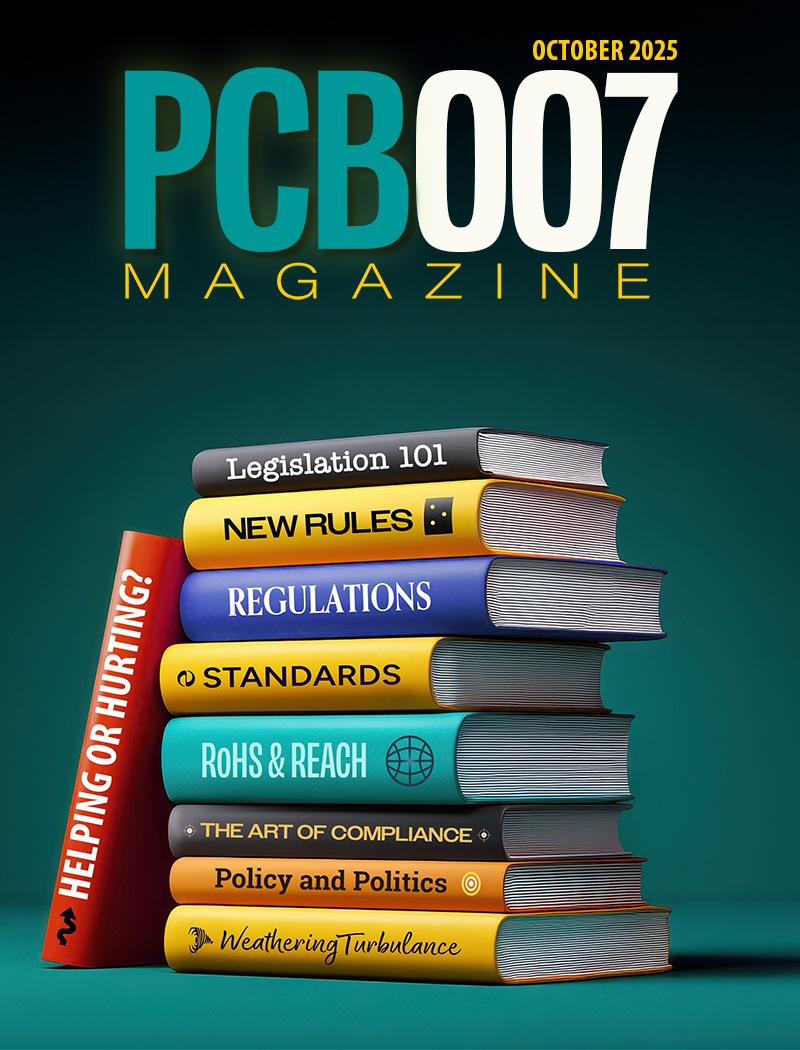-

- News
- Books
Featured Books
- pcb007 Magazine
Latest Issues
Current Issue
The Legislative Outlook: Helping or Hurting?
This month, we examine the rules and laws shaping the current global business landscape and how these factors may open some doors but may also complicate business operations, making profitability more challenging.

Advancing the Advanced Materials Discussion
Moore’s Law is no more, and the advanced material solutions to grapple with this reality are surprising, stunning, and perhaps a bit daunting. Buckle up for a dive into advanced materials and a glimpse into the next chapters of electronics manufacturing.

Inventing the Future With SEL
Two years after launching its state-of-the-art PCB facility, SEL shares lessons in vision, execution, and innovation, plus insights from industry icons and technology leaders shaping the future of PCB fabrication.
- Articles
- Columns
- Links
- Media kit
||| MENU - pcb007 Magazine
Recycling PCBs: How NCAB is Navigating Challenges and Embracing Opportunities
February 22, 2024 | Jan Pedersen, NCAB GroupEstimated reading time: 1 minute
In a recent article for Design007 about sustainable PCBs, my colleague Ramon Roche wrote about the various environmental regulatory requirements all of us have to meet every day. He emphasized that regulations are used as a starting point. He stated, “We also require our suppliers to comply with local social and environmental regulations and be ISO 9001 and ISO 14001 certified, where applicable.”
The ambition to create sustainable printed circuit boards (PCBs) is a continuous effort, and no single regulation makes a complete solution. However, applying all these standards together can help to create the most sustainable PCB possible.
Regulations are there to move the world in a direction, but in reality, the most significant effect is ensuring we efficiently use existing technologies and services. These regulations can be considered starting points instead of endpoints. We see that the industry can aim for more: We want to see actual steps toward a fully recyclable PCB, whether that is achieved through closed-loop processes or environmentally friendly end-of-life disposal.
The escalating use of electronic products has led to a critical environmental issue known as electronic waste. Among the key contributors to this waste stream are PCBs. As a result, the concept of PCB recyclability has gained significant traction within NCAB, driven by technological advancements and a growing environmental consciousness.
We have a strong commitment to sustainability and want to help others consider advancing the concept of circularity in PCB production and amplifying its significance in creating more sustainable PCBs. This is not without challenges, which include recycling PCBs and the potential of reusing organic PCB residues for new products. We see promising technologies that give us confidence that we can achieve fully recyclable PCBs and we highlight one of those projects in this article.
To read the rest of this article, which appeared in the Winter 2024 issue of IPC Community, click here.
Testimonial
"Your magazines are a great platform for people to exchange knowledge. Thank you for the work that you do."
Simon Khesin - Schmoll MaschinenSuggested Items
Zhen Ding Highlights AI PCBs, IC Substrates at TPCA 2025
10/22/2025 | Zhen DingThe annual PCB industry event, TPCA Show 2025, kicked off on October 22 at the Nangang Exhibition Center. Zhen Ding Tech Group showcased a full range of high-end PCBs and IC substrates under the theme of artificial intelligence (AI).
HT Global Circuits Adds Two atg Luther & Maelzer Flying Probe Test Systems
10/15/2025 | atg Luther & Maelzer GmbHAtg Luther & Maelzer GmbH, a leading supplier of electrical testing solutions for the PCB industry, and IEC USA, a distributor of consumables, equipment, and services in the North American PCB market, confirm the order for high-speed bare board testing technology.
Fresh PCB Concepts: Investing in Tomorrow's PCB Experts Today
09/24/2025 | Team NCAB -- Column: Fresh PCB ConceptsPeople often describe the PCB industry as one of the most critical yet invisible foundations of modern electronics. Every project needs a PCB, but few college programs or engineering curricula cover the complexity of board design, stackups, or manufacturability. That means the responsibility for developing the next generation of PCB experts falls on the industry itself.
American Made Advocacy: Congress Back from Break With Work To Do
09/23/2025 | Shane Whiteside -- Column: American Made AdvocacyAs Washington wakes up after the August Congressional recess, leaders from both sides of the aisle confront a host of serious policy challenges. One of the challenges is reauthorizing the Defense Production Act (DPA), a U.S. law that gives the president broad authority to influence the domestic industrial base to support national defense and emergency preparedness.
Electrodeposited Copper Foils Market to Grow by $11.7 Billion Over 2025-2032
09/18/2025 | Globe NewswireThe global electrodeposited copper foils market is poised for dynamic growth, driven by the rising adoption in advanced electronics and renewable energy storage solutions.


